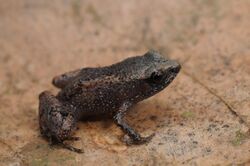Biology:Adelophryne
| Adelophryne | |
|---|---|

| |
| Adelophryne mucronatus | |
| Scientific classification | |
| Domain: | Eukaryota |
| Kingdom: | Animalia |
| Phylum: | Chordata |
| Class: | Amphibia |
| Order: | Anura |
| Family: | Eleutherodactylidae |
| Subfamily: | Phyzelaphryninae |
| Genus: | Adelophryne |
| Type species | |
| Adelophryne adiastola Hoogmoed and Lescure, 1984[1]
| |
| Species | |
|
12, see text | |
Adelophryne is a genus of frogs in the family Eleutherodactylidae.[2][3] They are native to northern South America east of the Andes, known roughly from the area corresponding to the Guiana Shield, as well as to the coastal area of Bahia, Brazil. Whether the genus is truly distinct from Phyzelaphryne remains uncertain. Common name shield frogs has been proposed for this genus,[2] although the stem flea frog is used for some species.[4]
Etymology
The generic name is derived from the Greek words adelos, meaning "unseen, unknown, obscure", and phryne for "toad". It refers to the fact that these small frogs were seldom collected until relatively lately.[1]
Description
Adelophryne are small leaf-litter frogs. Adults of the largest species, A. patamona, measure no more than 23 mm (0.91 in) in snout–to–vent length and the remaining all are less than 17.5 mm (0.69 in).[4] At 7.6–9.1 mm (0.30–0.36 in) in males and 10–11.4 mm (0.39–0.45 in) in females, A. michelin is not only the smallest in the genus,[4] but among the smallest frogs of the Americas, with only a few Brachycephalus species, Eleutherodactylus iberia and E. limbatus being of roughly similar size.[5][6]
The pupil of Adelophryne is oval and horizontally oriented. The tympanum is distinct. The digits are flattened and have asymmetrically pointed, laterally grooved, elongate discs. No webbing is present. The fourth finger is reduced in size. Males have a large, external subgular vocal sac.[1]
Reproduction is through direct development, that is, eggs hatch directly into froglets, without free-living larval (tadpole) stage.[7] Before this was confirmed for Adelophryne maranguapensis, the relatively large size of the eggs in this genus led many researcher to conclude that direct development was likely to be present.[8]
Species
As of July 2021, there are twelve species:[2][3][9]
- Adelophryne adiastola Hoogmoed and Lescure, 1984
- Adelophryne amapaensis Taucce, Costa-Campos, Haddad & de Carvalho, 2020
- Adelophryne baturitensis Hoogmoed, Borges, and Cascon, 1994
- Adelophryne glandulata Lourenço de Moraes, Ferreira, Fouquet, and Bastos, 2014
- Adelophryne gutturosa Hoogmoed and Lescure, 1984
- Adelophryne maranguapensis Hoogmoed, Borges, and Cascon, 1994
- Adelophryne meridionalis Santana, Fonseca, Neves, and Carvalho, 2012
- Adelophryne michelin Lourenço-de-Moraes, Dias, Mira-Mendes, de Oliveira, Barth, Ruas, Vences, Solé, and Bastos, 2018
- Adelophryne mucronatus Lourenço-de-Moraes, Solé, and Toledo, 2012
- Adelophryne nordestina Lourenço-de-Moraes, Lisboa, Drummond, Moura, Moura, Lyra, Guarnieri, Mott, Hoogmoed, and Santana, 2021
- Adelophryne pachydactyla Hoogmoed, Borges, and Cascon, 1994
- Adelophryne patamona MacCulloch, Lathrop, Kok, Minter, Khan, and Barrio-Amoros, 2008
The genus is likely to contain several undescribed species.[4]
References
- ↑ 1.0 1.1 1.2 Hoogmoed, M.S.; Lescure, J. (1984). "A new genus and two new species of minute leptodactylid frogs from northern South America, with comments upon Phyzelaphryne (Amphibia: Anura: Leptodactylidae)". Zoologische Mededelingen 58: 85–115.
- ↑ 2.0 2.1 2.2 Frost, Darrel R. (2019). "Adelophryne Hoogmoed and Lescure, 1984". Amphibian Species of the World: an Online Reference. Version 6.0. American Museum of Natural History. http://research.amnh.org/vz/herpetology/amphibia/Amphibia/Anura/Brachycephaloidea/Eleutherodactylidae/Phyzelaphryninae/Adelophryne. Retrieved 1 November 2019.
- ↑ 3.0 3.1 "Eleutherodactylidae". AmphibiaWeb: Information on amphibian biology and conservation. [web application]. Berkeley, California: AmphibiaWeb. 2019. http://www.amphibiaweb.org/lists/Eleutherodactylidae.shtml. Retrieved 1 November 2019.
- ↑ 4.0 4.1 4.2 4.3 Lourenço-de-Moraes, Ricardo; Dias, Iuri R.; Mira-Mendes, Caio V.; Oliveira, Renan M. de; Barth, Adriane; Ruas, Danilo S.; Vences, Miguel; Solé, Mirco et al. (19 September 2018). "Diversity of miniaturized frogs of the genus Adelophryne (Anura: Eleutherodactylidae): A new species from the Atlantic Forest of northeast Brazil". PLOS ONE 13 (9): e0201781. doi:10.1371/journal.pone.0201781. PMID 30231059. Bibcode: 2018PLoSO..1301781L.
- ↑ "10 Smallest Frogs and Toads in the World". gonefroggin.com. 18 December 2017. https://gonefroggin.com/2017/12/18/10-smallest-frogs-in-the-world/. Retrieved 30 January 2020.
- ↑ Napoli, M.F.; Caramaschi, U.; Cruz, C.A.G.; Dias, I.R. (2011). "A new species of flea-toad, genus Brachycephalus Fitzinger (Amphibia: Anura: Brachycephalidae), from the Atlantic rainforest of southern Bahia, Brazil". Zootaxa 2739: 33–40. doi:10.11646/zootaxa.2739.1.3. http://www.repositorio.ufba.br/ri/handle/ri/6245.
- ↑ Hedges, S. B.; Duellman, W. E.; Heinicke, M. P. (2008). "New World direct-developing frogs (Anura: Terrarana): Molecular phylogeny, classification, biogeography, and conservation". Zootaxa 1737: 1–182. doi:10.11646/zootaxa.1737.1.1. http://www.hedgeslab.org/pubs/196.pdf.
- ↑ Cassiano-Lima, D.; Borges-Nojosa, D. M.; Cascon, P.; Cechin, S. Z. (2011). "The reproductive mode of Adelophryne maranguapensis Hoogmoed, Borges & Cascon, 1994 (Anura, Eleutherodactylidae) an endemic and threatened species from Atlantic Forests remnants in northern Brazil". North-Western Journal of Zoology 7 (1). http://biozoojournals.ro/nwjz/content/v7n1/nwjz.111109.Lima.pdf. Retrieved 15 March 2014.
- ↑ Taucce, Pedro P. G.; Costa-Campos, Carlos E.; Haddad, Célio F. B.; de Carvalho, Thiago R. (2020-11-20). "A New Amazonian Species of the Diminutive Frog Genus Adelophryne (Anura: Brachycephaloidea: Eleutherodactylidae) from the State of Amapá, Northern Brazil". Copeia 108 (4). doi:10.1643/CH-19-254. ISSN 0045-8511. https://bioone.org/journals/copeia/volume-108/issue-4/CH-19-254/A-New-Amazonian-Species-of-the-Diminutive-Frog-Genus-Adelophryne/10.1643/CH-19-254.full.
Wikidata ☰ Q130642 entry
 |

